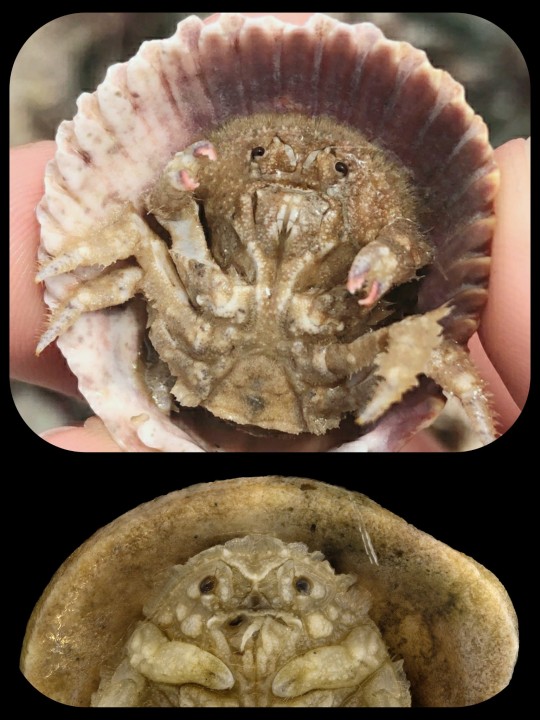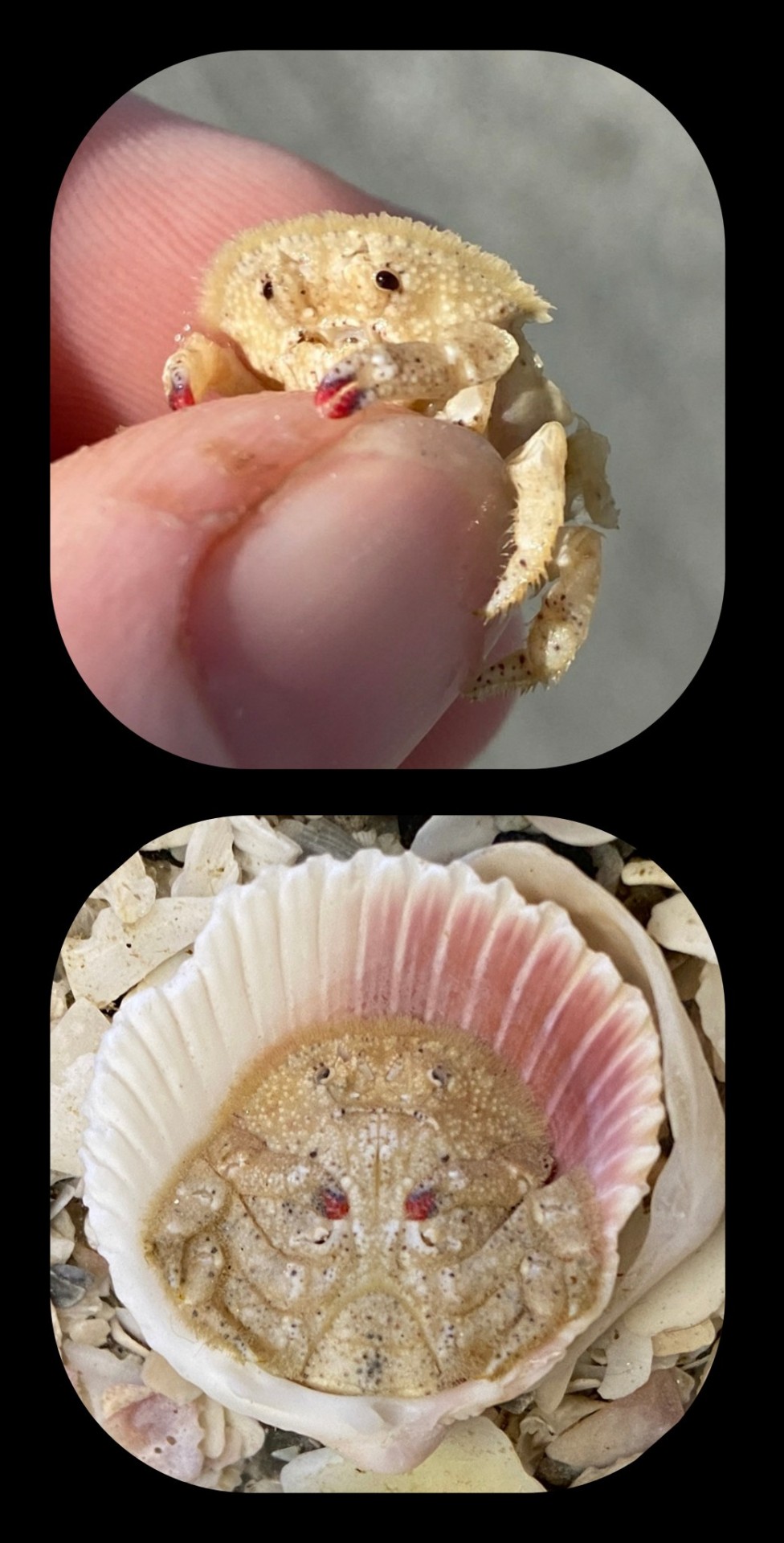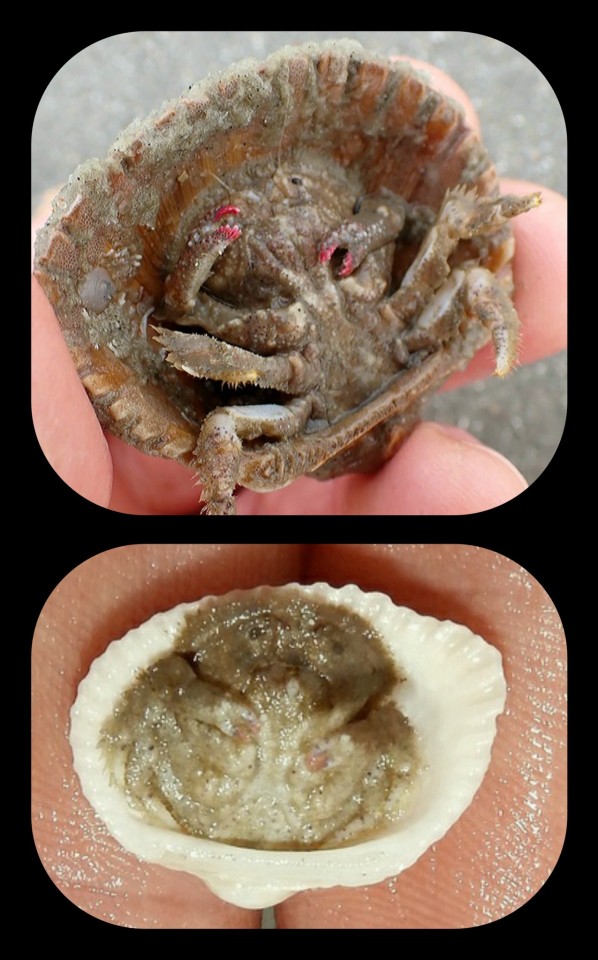#hypoconcha
Explore tagged Tumblr posts
Text
Shellback Crabs: these crabs create their own shields out of clamshells, and they have semi-membranous bodies that can be pressed into the contours of the shell, producing a suction mechanism that holds the shell in place

The crabs of this genus (Hypoconcha) have developed several unique adaptations that facilitate this kind of camouflage behavior. Many of the Dromiidae crabs, including sponge crabs and shellback crabs, are equipped with a specialized pair of legs that enable the crab to hold a shell, sea sponge, or ascidian against its body, but shellback crabs also have a flexible, semi-membranous body that can be tucked more firmly into the contours of a bivalve shell, producing a suction mechanism that keeps the shell firmly locked in place.

The body of the shellback crab is also covered in a very fine layer of hair-like structures known as setae, and when the crab presses itself against the shell, these membranous "hairs" can take on an almost translucent appearance, particularly around the margins of the crab's body.

I recently posted some photos and info about some of the crabs in the genus Lamarckdromia, which belongs to the same family, and as I was doing the background research for that post, I was just utterly mesmerized by all of the weirdly adorable crabs that seem to exist within the Dromiidae family. Each genus has its own unique adaptations that allow the crabs to use specific materials for camouflage -- some of them use living sponges, clamshells, ascidians, etc.

And I could not stop laughing at the little faces of these shellback crabs. They've all got the same bemused and indignant expression...like some random jerk just walked up to them, flipped them over, and announced to the entire ocean that there's a crab hiding beneath that disguise; as if that actually happens to them quite a lot, and they are getting really sick of it.

Sources & More Info:
Crustaceana Monographs: Comparison of the Shell-Carrying Behaviors of Desmodromia, Conchoecetes, and Hypoconcha (the relevant info is on page 191)
South Carolina Department of Natural Resources: Shellback Crabs and their Larval Stages (PDF)
South Carolina Public Radio: Shellback Crabs
#arthropod#crustacean#marine biology#sea life#crab#shellback crab#arthropods#hypoconcha#evolution#biology#cute animals#nature is weird#these guys look awfully crabby tho
13K notes
·
View notes
Text



Have You Ever Seen the Granulate Shellback Crab (Hypoconcha arcuata)? Read on information 👇
1 note
·
View note
Text

Peek-a-boo! Have you ever seen the granulate shellback crab (Hypoconcha arcuata)? Growing about 0.6 in (1.4 cm) long, this unusual-looking crustacean inhabits coastlines along parts of the western Atlantic, with a range that includes parts of the United States, Mexico, and Brazil. Unlike hermit crabs—which hide inside their chosen shells—this critter uses its posterior legs to secure shells onto its back, often shouldering pieces larger than its own body, as a defense against foes.
Photo: Austin Smith, CC BY 4.0, iNaturalist
#science#nature#natural history#animals#fact of the day#did you know#cool animals#marine biology#marine biodiversity#crabs#crustacean#fun facts#animal facts#ocean life
5K notes
·
View notes
Text

starting something new to keep my mind active - an Invert. Journal! i’m gonna start recording some of my favorite/interesting invertebrates and include some neat facts!
Hypoconcha sp.
including a picture of the Real Thing because my drawings can vary

3 notes
·
View notes
Text
Ces crabes créent leurs propres carapaces à partir de coquilles
See on Scoop.it - EntomoScience
Shellback Crabs: these crabs create their own shields out of clamshells; their semi-membranous bodies can be pressed into the contours of the shell, producing a suction mechanism that holds the shell…
Artifacts, Arthropods, and Anthropology on Tumblr
sixteenseveredhands
via Taupo @[email protected] sur X : "Les crabes hypoconches, mes prefs, ça change pas !" https://twitter.com/pierrekerner/status/1761360345153548360
-------
NDÉ
Traduction
"... leur corps semi-membraneux peut être plaqué dans les contours de la coquille, produisant un mécanisme de succion qui maintient la coquille en place.
Les membres de ce genre (Hypoconcha) possèdent une série d'adaptations uniques qui facilitent ce type de comportement de camouflage. De nombreux crabes de la famille des Dromiidae (bernard-l'ermite, bernard-éponges, crabes à dos de coquille, etc.) sont équipés d'une paire de pattes spécialisées qui leur permet de tenir une coquille, une éponge de mer et/ou une ascidie contre leur corps, mais les crabes à dos de coquille ont également un corps flexible, semi-membraneux, qui peut être pressé plus fermement dans les contours d'une coquille de bivalve, produisant un mécanisme de succion qui maintient fermement la coquille en place."
0 notes
Text
WIDDAWY FALLOUT
I LOVE THIS CRITTER
Shellback Crabs: these crabs create their own shields out of clamshells; their semi-membranous bodies can be pressed into the contours of the shell, producing a suction mechanism that holds the shell in place

The members of this genus (Hypoconcha) have a series of unique adaptations that facilitate this kind of camouflage behavior. Many of the Dromiidae crabs (e.g. hermit crabs, sponge crabs, shellback crabs, etc.) are equipped with a specialized pair of legs that enables the crab to hold a shell, sea sponge, and/or ascidian against their body, but shellback crabs also have a flexible, semi-membranous body that can be tucked more firmly into the contours of a bivalve shell, producing a suction mechanism that keeps the shell firmly locked in place.

The body of the shellback crab is also covered in a very fine layer of hair-like structures called setae, and when the crab presses itself against the shell, these membranous "hairs" can take on an almost translucent appearance, particularly around the margins of the crab's body.

I recently posted some photos/info about some of the crabs in the genus Lamarckdromia (which belongs to the same family) and as I was doing the background research for that post, I was just kind of mesmerized by all of these weirdly adorable crabs that seem to exist within the Dromiidae family tree. Each genus has its own unique adaptations that allow the crabs to use specific materials for camouflage -- some of them use living sponges, clamshells, ascidians, etc.
And I could not stop laughing at the little faces on these crabs. They've all got the same bemused/indignant expression...as if some random asshole has just walked up to them, shoved them over, and announced to the entire ocean that there's a crab hiding beneath that disguise; as if that actually happens to them quite a lot, and they're getting really sick of it.

Sources & More Info:
Crustaceana Monographs: Comparison of the Shell-Carrying Behaviors of Desmodromia, Conchoecetes, and Hypoconcha (the relevant info is on page 191)
South Carolina Department of Natural Resources: Shellback Crabs and their Larval Stages (PDF)
South Carolina Public Radio: Shellback Crabs
Again, I don't normally feature crustaceans on my blog...but I really couldn't resist this one.
#arthropod#crustacean#marine biology#sea life#crab#shellback crab#hypoconcha#evolution#biology#cute animals
13K notes
·
View notes
Text
I had never heard of these crabs until today, but they bring me immense joy and I think more people should experience this knowledge.
Shellback Crabs: these crabs create their own shields out of clamshells; their semi-membranous bodies can be pressed into the contours of the shell, producing a suction mechanism that holds the shell in place

The members of this genus (Hypoconcha) have a series of unique adaptations that facilitate this kind of camouflage behavior. Many of the Dromiidae crabs (e.g. hermit crabs, sponge crabs, shellback crabs, etc.) are equipped with a specialized pair of legs that enables the crab to hold a shell, sea sponge, and/or ascidian against their body, but shellback crabs also have a flexible, semi-membranous body that can be tucked more firmly into the contours of a bivalve shell, producing a suction mechanism that keeps the shell firmly locked in place.

The body of the shellback crab is also covered in a very fine layer of hair-like structures called setae, and when the crab presses itself against the shell, these membranous "hairs" can take on an almost translucent appearance, particularly around the margins of the crab's body.

I recently posted some photos/info about some of the crabs in the genus Lamarckdromia (which belongs to the same family) and as I was doing the background research for that post, I was just kind of mesmerized by all of these weirdly adorable crabs that seem to exist within the Dromiidae family tree. Each genus has its own unique adaptations that allow the crabs to use specific materials for camouflage -- some of them use living sponges, clamshells, ascidians, etc.
And I could not stop laughing at the little faces on these crabs. They've all got the same bemused/indignant expression...as if some random asshole has just walked up to them, shoved them over, and announced to the entire ocean that there's a crab hiding beneath that disguise; as if that actually happens to them quite a lot, and they're getting really sick of it.

Sources & More Info:
Crustaceana Monographs: Comparison of the Shell-Carrying Behaviors of Desmodromia, Conchoecetes, and Hypoconcha (the relevant info is on page 191)
South Carolina Department of Natural Resources: Shellback Crabs and their Larval Stages (PDF)
South Carolina Public Radio: Shellback Crabs
Again, I don't normally feature crustaceans on my blog...but I really couldn't resist this one.
#unique animals#marvelous camouflage#hypoconcha#dromiidae#crabs#just losing it looking at their offended little faces
13K notes
·
View notes